Somalia receives 1.6 million J&J COVID-19 vaccine doses from Sweden and the Czech Republic
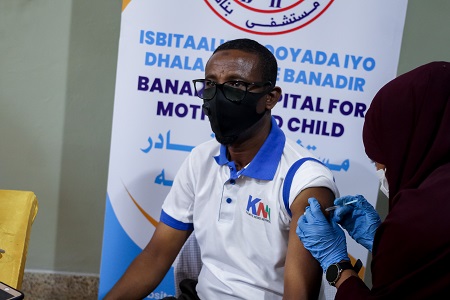 Credit: WHO/Somalia28 August 2022, Mogadishu – On 27 August 2022, Somalia received 1 645 600 doses of the Johnson and Johnson (J&J) COVID-19 vaccines from the Government of Sweden and the Government of the Czech Republic. The vaccines were donated by both countries through the COVAX Facility. So far, around 2.3 million people have been fully vaccinated against COVID-19 and over 1.9 million people partially vaccinated.
Credit: WHO/Somalia28 August 2022, Mogadishu – On 27 August 2022, Somalia received 1 645 600 doses of the Johnson and Johnson (J&J) COVID-19 vaccines from the Government of Sweden and the Government of the Czech Republic. The vaccines were donated by both countries through the COVAX Facility. So far, around 2.3 million people have been fully vaccinated against COVID-19 and over 1.9 million people partially vaccinated.
On this occasion, HE Dr Ali Haji Adam Abubakar, the Minister of Health and Human Services of the Federal Government of Somalia said, “We would like to express our sincere gratitude to the Government of Sweden and the Czech Republic for supporting us to protect Somalis against COVID-19. The vaccines we have received will indeed save lives, enable us to create more equity between Somalis of different backgrounds, and contribute to our national health goals to ensure we leave no one behind. This is even more important now as the country faces a severe drought and mass displacement, leaving more people vulnerable to diseases.”
The ongoing drought has brought the country to the brink of famine, and left 7.7 million people in need of humanitarian assistance and protection, and around 1 million people internally displaced.
“I am very proud that Sweden has yet again proved to be standing in solidarity with the people of Somalia to fight the COVID-19 pandemic. The 1 360 800 doses donated by the Swedish Government now will go a long way in helping Somalia getting more people vaccinated. In addition to the vaccine donation through COVAX, Sweden also has a long-term commitment and support to the health sector in Somalia, including financial support for health systems strengthening channeled through WHO, UNICEF, the United Nations Population Fund and Save the Children”, says the Swedish Ambassador to Somalia, Mr Per Lindgärde.
 Credit: WHO/SomaliaDr Mamunur Rahman Malik, WHO Representative to Somalia said, “Overall, 15% of Somalia’s population has been fully vaccinated against COVID-19 so far and 12% are partially vaccinated. Together with the Government, donors and other partners, we have used creative ways and impactful innovations to reach the most vulnerable people, prevent further spread of COVID-19 and leverage on these efforts to rebuild health systems. However, we still have a long way to go. Somalia’s aim is to vaccinate at least 40% of people by the end of 2022.”
Credit: WHO/SomaliaDr Mamunur Rahman Malik, WHO Representative to Somalia said, “Overall, 15% of Somalia’s population has been fully vaccinated against COVID-19 so far and 12% are partially vaccinated. Together with the Government, donors and other partners, we have used creative ways and impactful innovations to reach the most vulnerable people, prevent further spread of COVID-19 and leverage on these efforts to rebuild health systems. However, we still have a long way to go. Somalia’s aim is to vaccinate at least 40% of people by the end of 2022.”
“Somalia has made tangible progress in procuring safe and effective COVID-19 vaccines. UNICEF continues to work closely with the Government and partners to ensure communities are aware on the benefits of being vaccinated,” says Wafaa Saeed, UNICEF Somalia Representative. “The humanitarian situation calls for urgent measures to scale up COVID-19 vaccination and other lifesaving humanitarian assistance, especially for internally displaced persons, rural communities and nomads.”
Some of the challenges slowing down COVID-19 vaccination in Somalia include limited access to specific areas due to insecurity or logistical challenges.
For additional information, please contact:
Khadar Hussein Mohamud
Head of Coordination and Communications
Ministry of Health, Federal Government of Somalia
Mukhtar Abdi Shube
Head of the Expanded Programme on Immunization (EPI) section
Ministry of Health
Federal Government of Somalia
Fouzia Bano
Communications Officer
WHO Somalia
Lisa Hill
Communications Specialist
UNICEF Somalia
Teamwork at all levels of WHO aims to save millions of lives in the greater Horn of Africa
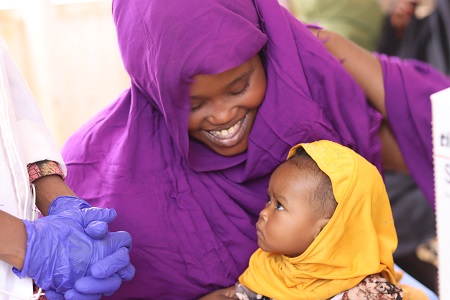 WHO is working to reach children with vital vaccinations. Around 7 million under-5s are acutely malnourished and have low immunity in the region. Credit: WHO Somalia28 August 2022 – In the greater Horn of Africa, famine is looming at the doorstep of many households. Over 80 million people in this region — which comprises Djibouti, Ethiopia, Kenya, Somalia, South Sudan, Sudan and Uganda — lack access to food that would meet their basic needs along with safe water. More than 37 million of these people have reached crossroads in their lives where they have had to sell their possessions to feed themselves and their families.
WHO is working to reach children with vital vaccinations. Around 7 million under-5s are acutely malnourished and have low immunity in the region. Credit: WHO Somalia28 August 2022 – In the greater Horn of Africa, famine is looming at the doorstep of many households. Over 80 million people in this region — which comprises Djibouti, Ethiopia, Kenya, Somalia, South Sudan, Sudan and Uganda — lack access to food that would meet their basic needs along with safe water. More than 37 million of these people have reached crossroads in their lives where they have had to sell their possessions to feed themselves and their families.
In this dire situation, the risk of morbidity and mortality due to outbreak-prone diseases comes in tandem with forced displacement. This is set against a backdrop of limited access to essential and primary health care interventions across the entire region. Each day, the most vulnerable populations, including children, pregnant and breastfeeding women, and displaced people, are facing growing threats of being infected with communicable diseases.
Outbreaks in the Region
The drought has exacerbated disease outbreaks in the Horn of Africa, a region that is constantly facing other emergencies, including the COVID-19 pandemic currently. Djibouti, Ethiopia, Somalia, South Sudan, Sudan and Uganda are experiencing measles outbreaks, while Kenya, Somalia and South Sudan are witnessing cholera outbreaks.
 WHO has supported nutrition stabilization centres to save the lives of children with severe acute malnutrition with medical complications. Credit: WHO/SomaliaThe countries also have high rates of severe acute malnutrition among children under 5 years old, all of which increase the risk of morbidity and mortality among displaced and vulnerable populations. Unless a coordinated response effort is implemented, health risks will keep escalating and spreading within and beyond the region.
WHO has supported nutrition stabilization centres to save the lives of children with severe acute malnutrition with medical complications. Credit: WHO/SomaliaThe countries also have high rates of severe acute malnutrition among children under 5 years old, all of which increase the risk of morbidity and mortality among displaced and vulnerable populations. Unless a coordinated response effort is implemented, health risks will keep escalating and spreading within and beyond the region.
Charting out plans for stronger collaboration
To continue to deter these severe health consequences of the drought in a coordinated manner in the greater Horn of Africa, the World Health Organization (WHO) convened a meeting from 26 to 27 June 2022 in Nairobi, Kenya, for the organization’s senior specialists and officials. These experts included Dr Ibrahima Socé Fall, WHO Assistant Director-General for Emergency Response, the WHO Representatives from the 7 countries of the region, and other technical expertise.
The participants set out to brainstorm ways to mount a stronger and coherent health response. They considered joint measures to improve primary health care interventions, including in the delivery of essential health services, nutrition support and immunization, communication and resource mobilization, and regional, inter-agency, and partner coordination. They also discussed the alignment of response plans, and health intelligence and information products and systems. After finalizing the Contingency Fund for Emergencies, an emergency fund run by WHO, the country teams also agreed on a series of next steps to take to advance recommended action.
Coordinating information management in the Region
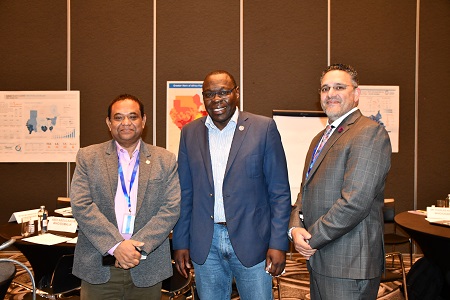 Dr Mamunur Rahman Malik, WHO Representative to Somalia, Dr Ibrahima Soce Fall, WHO Assistant Director-General for Emergency Response, and Mr Altaf Musani, WHO Director of Emergency Health Interventions, at a Greater Horn of Africa drought response meeting, Nairobi. Credit: WHO/SomaliaAs next steps, the information management teams from all 7 countries, and representatives from the WHO Regional Office for Africa, Regional Offfice for the Eastern Mediterranean and headquarters convened a meeting in Kenya from 25 to 27 July 2022. The team aimed to understand and document the information and data landscape across the region. They also discussed ways to enhance coordination using 4 health information management pathways – products, processes, people and tools – and the need for monitoring and evaluation, including on indicators related to nutrition, which is closely linked to health, and primary health care.
Dr Mamunur Rahman Malik, WHO Representative to Somalia, Dr Ibrahima Soce Fall, WHO Assistant Director-General for Emergency Response, and Mr Altaf Musani, WHO Director of Emergency Health Interventions, at a Greater Horn of Africa drought response meeting, Nairobi. Credit: WHO/SomaliaAs next steps, the information management teams from all 7 countries, and representatives from the WHO Regional Office for Africa, Regional Offfice for the Eastern Mediterranean and headquarters convened a meeting in Kenya from 25 to 27 July 2022. The team aimed to understand and document the information and data landscape across the region. They also discussed ways to enhance coordination using 4 health information management pathways – products, processes, people and tools – and the need for monitoring and evaluation, including on indicators related to nutrition, which is closely linked to health, and primary health care.
Following an analysis of all the different information collection tools and siloed, donor-driven individual disease management systems in the 7 countries, the participants agreed on the need to integrate health information management assets in the countries into a single cohesive integrated system.
In conclusion, the team agreed to create a joint situation report every month – that combines an epidemiological bulletin, known as the EPI watch, and a visually appealing infographic on the drought situation. They also agreed to create a general dashboard that shows drought response activities for each of the 7 countries. It will present information on malaria activities, cholera, interventions by community health workers, outreach interventions, and severe acute malnutrition stabilization centres in drought-affected areas.
Regional and country appeals for support
To scale up the response to the situation in the greater Horn of Africa, on 2 August 2022, WHO launched an appeal for US$ 123.7 million. The response will focus on 5 pillars: coordination and collaboration; surveillance and information; outbreak prevention and control; essential nutrition actions; and essential health services.
In Somalia, WHO launched an emergency health response plan for the ongoing drought in May 2022. With an ask of US$ 35 million until the end of 2022, the plan aims to strengthen disease surveillance, integrate nutrition programmes horizontally into health service delivery, and ensure adequate coverage levels of measles and polio vaccination, including vitamin A and deworming. Additionally, the plan will ensure the delivery of essential package of health services with nutrition and mental health and psychosocial support integrated in activities. To cater for the needs of young children and women, the response would also address integrated management of childhood illnesses and reproductive health.
“Since early last year, in Somalia, our urgent attention has focused on anticipating and averting severe health consequences of drought. We advocated for early action for the drought response to avoid regret, and for flexible and urgent funding to support our efforts. Since then, we have left no stone unturned to work towards preventing avoidable morbidity and mortality linked to epidemic-prone diseases, caused by limited access to safe water, food, proper sanitation and hygiene. In many ways, we have managed to avert large-scale losses of life, but even one life lost is too many,” said Dr Mamunur Rahman Malik, WHO Representative to Somalia.
Partnerships at WHO levels and with donors saving lives
Commenting on the extraordinary efforts to improve partnerships within WHO, Dr Malik, the WHO Somalia Head of Mission said, “Across the greater Horn of Africa, WHO is ramping up its response, improving coordination, and streamlining existing efforts and optimizing on resources to ensure we reach more people with life-saving support. With one million displaced Somalis, we have one million and more reasons to redouble our efforts and extend additional support to affected families.”
He added that the support from partners such as the European Union (EU) Delegation to Somalia, European Civil Protection and Humanitarian Aid Operations of Somalia, donors contributing to the Contingency Fund for Emergencies, and Gavi - the Vaccine Alliance, WHO has already been able to impact the lives of some of the hardest hit people.
For additional information on the appeals launched by WHO for the greater Horn of Africa and Somalia to respond to the ongoing drought:
Contingency Fund for Emergencies (who.int)
Contributions and allocations (who.int)
USAID and WHO team up to mitigate the impact of COVID-19 on Somalia
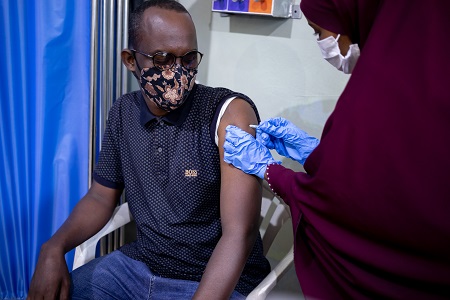 The WHO-USAID project will improve COVID-19 vaccination rates across Somalia25 August 2022, Mogadishu – The World Health Organization (WHO) country office for Somalia and the United States Agency for International Development (USAID) have launched a new project which aims to fill current needs to prevent community spread of COVID-19 across Somalia. The project will address existing gaps in coordination, surveillance, vaccination and the operational response to COVID-19 and help the country’s health system recover from the pandemic towards a more inclusive and equitable system.
The WHO-USAID project will improve COVID-19 vaccination rates across Somalia25 August 2022, Mogadishu – The World Health Organization (WHO) country office for Somalia and the United States Agency for International Development (USAID) have launched a new project which aims to fill current needs to prevent community spread of COVID-19 across Somalia. The project will address existing gaps in coordination, surveillance, vaccination and the operational response to COVID-19 and help the country’s health system recover from the pandemic towards a more inclusive and equitable system.
As of 24 August 2022, Somalia had 27 137 laboratory confirmed cases of COVID-19, and 1351 related deaths. The country’s disease surveillance system remains fragmented and weak. Currently, only 62% of health facilities in Somalia are reporting through the early warning and alert and response network. The country was able to vaccinate only 15% of its population against COVID-19 fully, leaving a large number of high-risk populations unvaccinated. Somalia’s fragile health system has been struggling to sustain the progress made in containing and mitigating the transmission of COVID-19 among vulnerable populations, especially among around 47% of people who live in hard-to-reach areas, where disease reporting is weak and incomplete. This results in underreporting and the actual magnitude and size of the COVID-19 epidemic in the country may not represent the true burden of the disease.
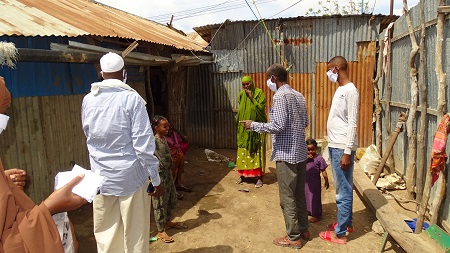 Health care workers visit households to share messages on how to prevent COVID-19 and manage cases“With the guiding principle that no one is safe until everyone is safe, in collaboration with USAID and the Somali Government, WHO will ramp up measures to contain and suppress the spread of COVID-19. This would prevent resurgence of the virus. It would also minimize adverse effects of the pandemic on other life-saving essential health services, such as routine immunization for children, which has already slid back substantively in the last 2 years. USAID’s continued commitment and partnership will support Somalis to access the most basic, essential health services that they need, while preparing Somalia for current and future health emergencies,” said Dr Mamunur Rahman Malik, WHO Representative to Somalia.
Health care workers visit households to share messages on how to prevent COVID-19 and manage cases“With the guiding principle that no one is safe until everyone is safe, in collaboration with USAID and the Somali Government, WHO will ramp up measures to contain and suppress the spread of COVID-19. This would prevent resurgence of the virus. It would also minimize adverse effects of the pandemic on other life-saving essential health services, such as routine immunization for children, which has already slid back substantively in the last 2 years. USAID’s continued commitment and partnership will support Somalis to access the most basic, essential health services that they need, while preparing Somalia for current and future health emergencies,” said Dr Mamunur Rahman Malik, WHO Representative to Somalia.
“The United States, WHO, and Somalia’s federal and state governments are collaborating on this lifesaving intervention. Our effort aligns with our commitment to the global response to the COVID-19 pandemic. As of 8 August, the United States, through coordinated efforts with Gavi and recipient countries, has delivered 588 million vaccine doses to 115 countries, including 43 countries in Sub-Saharan Africa. Those numbers increase each month. This project will improve the response of Somalia’s health care system to the pandemic and other pressing health crises. It will also increase vaccination rates,” said Larry André, U.S. Ambassador to Somalia.
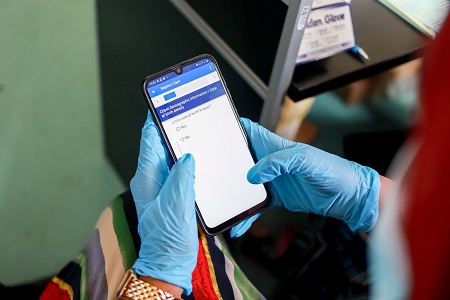 The project will support the sharing of COVID-19 data among partners, which will guide decision-makingThe COVID-19 vaccine uptake in Somalia currently stands at 15%. Unless this low vaccination coverage rate is scaled up, it may result in successive waves of the epidemic, and a high probability of deaths among vulnerable and at-risk populations. This is particularly as the country has porous, largely unmonitored borders with neighbouring countries where COVID-19 is still in circulation, and mass displacement due to the ongoing drought.
The project will support the sharing of COVID-19 data among partners, which will guide decision-makingThe COVID-19 vaccine uptake in Somalia currently stands at 15%. Unless this low vaccination coverage rate is scaled up, it may result in successive waves of the epidemic, and a high probability of deaths among vulnerable and at-risk populations. This is particularly as the country has porous, largely unmonitored borders with neighbouring countries where COVID-19 is still in circulation, and mass displacement due to the ongoing drought.
By way of this project, WHO will work to limit communities’ exposure to COVID-19 and reduce mortality and morbidity among vulnerable populations. This will be accomplished by supporting the federal government and federal members states of Somalia to: 1) strengthen intersectoral and intergovernmental planning and coordination for sustained emergency operational response; 2) maintain active surveillance for early case detection, laboratory-confirmation and contact tracing; and 3) improve information and data sharing, including innovation and research. An effective and robust response to COVID-19 outbreaks will be crucial to save lives, reduce the disease burden, and protect the health of the general population.
For additional information, please contact:
Eloi Yao
Senior Development Outreach and Communications Specialist
USAID Somalia
Keisha Herbert
Deputy Program Office Director
USAID Somalia
Kyle DeFreitas
External Relations Officer
WHO Somalia
Fouzia Bano
Communications Officer
WHO Somalia
Balancing priorities in the midst of a drought: vaccination campaigns break measles transmission among children in Somalia and save lives
 The measles immunization campaign vaccinated close to half a million children aged from 6 to 59 months to boost their immunity. Credit: WHO/Mukhtar Sudani10 August 2022 – In the Washington camp for internally displaced persons (IDPs) in Garowe, Deka Abdi Dacar learnt about measles, known as jadeeco in Somali after her experience. She lost 2 of her 4 children, aged 2 and 4, as they had measles with other complications. Both her young sons had fever, coughs and a rash for a few days before Deka and her family took them to the hospital. She solemnly adds that although she really regrets not knowing about measles vaccines before, she is still grateful she managed to vaccinate 2 of her children.
The measles immunization campaign vaccinated close to half a million children aged from 6 to 59 months to boost their immunity. Credit: WHO/Mukhtar Sudani10 August 2022 – In the Washington camp for internally displaced persons (IDPs) in Garowe, Deka Abdi Dacar learnt about measles, known as jadeeco in Somali after her experience. She lost 2 of her 4 children, aged 2 and 4, as they had measles with other complications. Both her young sons had fever, coughs and a rash for a few days before Deka and her family took them to the hospital. She solemnly adds that although she really regrets not knowing about measles vaccines before, she is still grateful she managed to vaccinate 2 of her children.
Prevalence of measles
Measles has been endemic in Somalia for years. One of the largest outbreaks was reported in 2017, when 23 039 suspected cases were reported across 118 of the country’s operational districts and the Banadir administrative region.
Since then, the prevalence of measles has varied each year. In 2020, Somalia recorded 9562 suspected measles cases, and a year later, in 2021, the country reported 7494 suspected measles cases. From January to July 2022, the country has had 11 972 suspected measles cases, which is a large spike as compared to previous years.
Drought increasing chances of measles spreading
Over the years, Somali children like Deka’s have had to bear the brunt of fragile health systems, an underpaid health workforce that has limited skills, low levels of health education among the population, and protracted conflict and insecurity.
Recurring emergencies in Somalia add on to health challenges that communities face, and resulting mass displacement fuels the spread of diseases. As a result of the drought that hit Somalia in 2021, an estimated 1.5 million children aged under 5 years face acute malnutrition, with over 380 000 likely to experience severe malnourishment. Children who are severely malnourished are at a high risk of falling ill – they are 9 times more likely to die of diseases such as measles, or acute watery diarrhoea/cholera.
The drought, which is showing signs of turning into imminent famine, has affected 7 countries in the Greater Horn of Africa - Djibouti, Ethiopia, Kenya, Somalia, South Sudan, Sudan and Uganda. Six of these countries, including Somalia, are witnessing measles outbreaks.
“As long as Somalia and neighbouring countries have pockets of under-immunized children and low routine immunization rates, preventable diseases like measles will keep reversing gains made so far and affecting children,” said Dr Mamunur Rahman Malik, WHO Representative to Somalia. “WHO-UNICEF estimates state that only around 46% of children in Somalia have received their first dose of measles in the last decade. We all need to redouble our efforts to reach the other half of the population of children, especially as COVID-19 has already contributed to childhood immunization sliding backwards in Somalia.”
Measles vaccination campaign reaches over 459 000 children
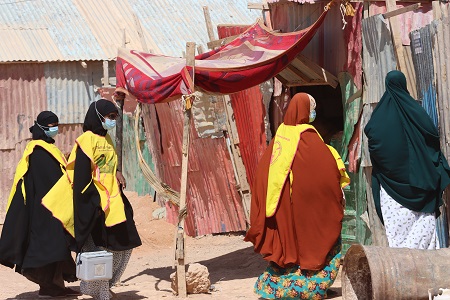 Health care workers, many of whom are women, focus on vulnerable communities and children while delivering health services. Credit: WHO/Mukhtar SudaniTo prevent measles from spreading, the World Health Organization (WHO) and United Nations Children’s Fund (UNICEF) provided crucial support to the Puntland and Galmudug Ministries of Health to conduct a measles vaccination campaign from 20 to 29 July 2022. The campaign covered children in 15 districts in Puntland and 2 districts in Galmudug.
Health care workers, many of whom are women, focus on vulnerable communities and children while delivering health services. Credit: WHO/Mukhtar SudaniTo prevent measles from spreading, the World Health Organization (WHO) and United Nations Children’s Fund (UNICEF) provided crucial support to the Puntland and Galmudug Ministries of Health to conduct a measles vaccination campaign from 20 to 29 July 2022. The campaign covered children in 15 districts in Puntland and 2 districts in Galmudug.
As part of the intervention, 466 outreach teams vaccinated 459 478 children aged from 6 to 59 months out of a targeted 487 909 (94% of the target), according to preliminary data collected and analyzed. Two thirds of the outreach vaccination teams were deployed in urban areas, while a third focused on camps and households in rural areas. Additionally, 83 supervisors and monitors were deployed to maintain the quality of services provided and ensure that vaccinators were following COVID-19 protocols while interacting with communities. During the campaign, social mobilizers shared messages about the dates of the campaign, location of vaccination sites and benefits of vaccination with communities.
The campaign had a special focus on children from vulnerable populations, including those living in internally displaced camps.
Support from partners and health workers going a long way
Dr Mamunur Malik, the Head of the Mission of WHO Somalia, also expressed his profound gratitude to donors such as Gavi - the Vaccine Alliance, the European Union (EU) Delegation to Somalia, European Civil Protection and Humanitarian Aid Operations of Somalia, as well as the donors contributing to Contingency Funds for Emergencies of WHO for supporting, safeguarding and protecting vulnerable Somali children, living in some of the worst, life-threatening conditions caused by the current drought, occurring in a challenging environment.
With support from partners, Somalia introduced the second dose of measles-containing vaccine (MCV2) in children’s routine immunization schedule in November 2021, around the same time the Government declared the drought a national emergency in the country.
In general, communities are also supportive of health service delivery in the country. Asha Ali, a vaccinator who was involved in the measles campaign explains, “Somali parents are usually supportive of vaccination campaigns. However, I did meet 3 families who refused to get their children vaccinated initially. After we explained the benefits of vaccination, along with social mobilizers and supervisors, they agreed to vaccinate their children. It makes me happy to see situations like this, where we can make a difference to keep children healthy.”
Additional information on the drought and measles in Somalia can be found below:
WHO launches appeal to respond to urgent health needs in the greater Horn of Africa
WHO EMRO | Protecting children from measles in drought-affected Somalia | News | Somalia site


